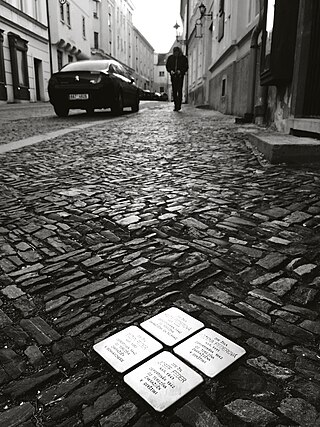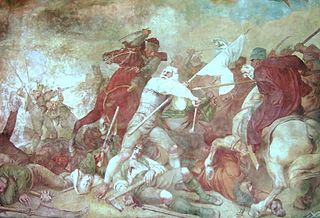History
During the Bavarian uprising of 1705 and 1706 the country defense congress ("Braunau Parliament") was held in Braunau. In addition to leader Johann Georg Meindl, born in Weng, Christian Probst wrote of other leaders from the court of Braunau: old Hofbauer from Wuerlach, the rotbartete Schwaiger, Schienkhueber zu Mitterndorf, Neuhauser zu Hochburg, Meindlsberger in office at Eggelsberg, the innkeeper of Ibm and Baron of Taufkirchen, who was a civil servant there.
The district was created in 1868.
Franz Xaver Gruber composer of the Christmas carol "Stille Nacht" ("Silent Night") was born in the district in 1787. Adolf Hitler was born here on 20 April 1889.

Braunau am Inn is a town in Upper Austria on the border with Germany. It is known for being the birthplace of Adolf Hitler.

The Innviertel is a traditional Austrian region southeast of the Inn river. It forms the western part of the state of Upper Austria and borders the German state of Bavaria. The Innviertel is one of the four traditional "quarters" of Upper Austria, the others being Hausruckviertel, Mühlviertel, and Traunviertel.

Gerhard Skiba was an Austrian politician of the Austrian Social Democratic Party elected mayor of the city of Braunau am Inn in 1989. He became internationally known after setting up a memorial stone for the victims of Fascism in front of the house where Adolf Hitler was born.
Sankt Georgen may refer to several places, all named after the German name of Saint George:
Bezirk Ried is a district of the state of Upper Austria in Austria.
Bezirk Schärding is a district of the state of Upper Austria in Austria.
Bezirk Krems is a district of the state of Lower Austria in Austria. It comprises the areas to the south, west and north of the city of Krems an der Donau, which itself is a statutory city.

A Stolperstein is a ten-centimetre (3.9 in) concrete cube bearing a brass plate inscribed with the name and life dates of victims of Nazi extermination or persecution. Literally, it means 'stumbling stone' and metaphorically 'stumbling block'.
The Stolpersteine in the district of Braunau am Inn are small, cobble stone-sized memorials to the former residents of the district who perished at the hands of the Nazis during the Third Reich. Conceived and installed by Cologne artist Gunter Demnig, they were set in the pavement at various locations between August 11–12, 2006.

The Nomenclature of Territorial Units for Statistics (NUTS) is a geocode standard for referencing the subdivisions of Austria for statistical purposes. The standard is developed and regulated by the European Union. The NUTS standard is instrumental in delivering the European Union's Structural Funds. The NUTS code for Austria is AT and a hierarchy of three levels is established by Eurostat. Below these is a further levels of geographic organisation - the local administrative unit (LAU). In Austria, the LAU 2 is municipalities.

Kirchberg bei Mattighofen is a municipality in the district of Braunau am Inn in the Austrian state of Upper Austria.

Polling im Innkreis is a municipality in the district of Braunau am Inn in the Austrian state of Upper Austria.
Schwand im Innkreis is a municipality in the district of Braunau am Inn in the Austrian state of Upper Austria.

Weng im Innkreis is a municipality in the district of Braunau am Inn in the Austrian state of Upper Austria.
Ammerer Bed Company is an Austrian family business operating in its eighth generation, established in 1763. Specialising in sleeping systems and textile design, their services encompass a range of activities including a curtain-sewing workshop, bed sanitisation, furniture upholstery, home servicing, mattress delivery and disposal, monogram embroidery, 3D room planning, as well as the organisation of wedding tables.
Arts Initiative KNIE was founded as an initiative for contemporary art in 1995 in Oberndorf bei Salzburg. It is the origin of the stolperstein project in Braunau am Inn District.

The Bavarian uprising of 1705–1706 was a revolt against the occupation of the Electorate of Bavaria by the Imperial Army of the Habsburg Monarchy during the War of the Spanish Succession (1701–1714). It lasted from early November 1705 to 18 January 1706, approximately 75 days. Henric L. Wuermeling speaks of this as "the first revolution of modern history."

Gunter Demnig is a German artist. He is best known for his Stolperstein memorials to the victims of Nazi persecution, including Jews, homosexuals, Romani and the disabled. The project places engraved brass stones in front of a former residence for a Holocaust victim who was deported and murdered by Nazi Germany. The memorial effort began in Germany and has since spread, with more than 100,000 stones placed across 26 countries in Europe.
This page is based on this
Wikipedia article Text is available under the
CC BY-SA 4.0 license; additional terms may apply.
Images, videos and audio are available under their respective licenses.











